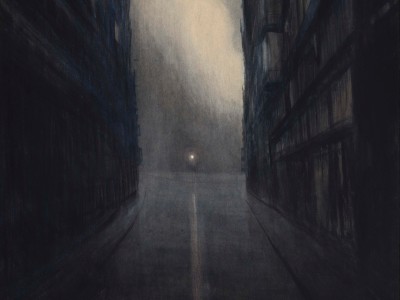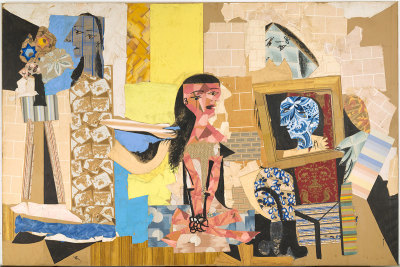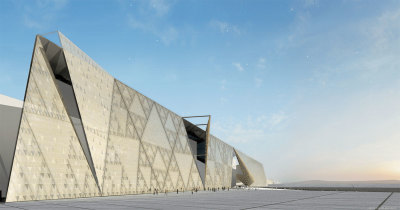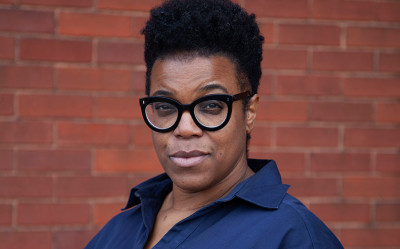Can artists and designers help save the world?
Can artists and designers help save the world?
By Sam Solnick
Published 26 November 2019
Our exhibition, ‘Eco-Visionaries’, not only reflects a planet undergoing profound change but proposes ways to adapt without succumbing to apathy or inertia.
-
From the Winter 2019 issue of RA Magazine, issued quarterly to Friends of the RA. Sam Solnick is Lecturer in English Literature at the University of Liverpool, and author of Poetry and the Anthropocene (Routledge).
-
In his 1977 essay Why Look at Animals, the late John Berger laments the growth of the modern zoo and its correlation with the disappearance of animals from everyday life from the Industrial Revolution onwards. For Berger, zoos are an endorsement of colonial power, a symbol of the conquest of distant and exotic lands. The species that visitors look at have been rendered marginal. They are living reminders of a faraway wild, wholly dependent on their keepers and dwelling in habitats that are pathetic simulations of the native environments to which they are adapted.
-
Made 40 years after Berger’s influential text, the art installation win > < win (2017) by the collective Rimini Protokoll is one of several pieces in the RA’s ecological exhibition, Eco-Visionaries, that reframes the relationship between species and their habitats.
In win > < win’s case, the focus is on jellyfish and human beings. In this interactive work, viewers begin by looking at themselves in a mirror while listening to an audio track through headphones. A male voice poses questions to the viewers about their age and mortality, asking them to respond with gestures such as putting up their hands. The lighting then changes, the mirror turning into a viewing portal for a tank full of gelatinous sea stingers.
-

Rimini Protokoll, win > < win..
Installation view, Eco-Visionaries: Confronting a planet in a state of emergency, Royal Academy of Arts, London, 23 November 2019 — 23 February 2020..
Photo: © Royal Academy of Arts, London / David Parry.
-
The audio track compares humanity’s evolutionary adaptability to that of the jellyfish. These animals are not marginal zoo specimens, but instead carnivores that are rapidly proliferating due to climate change phenomena such as warmer seas and a scarcity of the endangered sea turtles that prey on them. These tentacled icons of changing ecosystems increasingly impinge on human activities: wiping out fish stocks in a South Australian port, clogging a Swedish nuclear power station.
Finally the light shifts again, allowing the viewer to see through the tank to the faces of another set of visitors, who are responding to the same questions and unable to see the original viewers through what we now realise is a two-way mirror. Their unaware gesticulations suggest human vulnerability on both an individual and a species level. We will not be the dominant species forever or even – on an evolutionary scale – for very long.
Alexandra Daisy Ginsberg’s video installation The Substitute (2019), in contrast, makes the viewing of a critically endangered creature – the northern white rhinoceros – wholly virtual.
Only two members of this subspecies are known to exist, and both are female and live in captivity. Ginsberg used a digital model of a rhino that moves around in a virtual space informed by a combination of AI and rare research footage of the last herd. This digital substitute appears in thrilling audio-visual detail, its grunts and huffs perhaps closer to the wild animal than any in a zoo. But we also see the rhino evolve from a mesh of pixels, reminding us that this is a merely a virtual creature.
The Substitute asks us to consider how technology might reconstruct – as well as sever – our ties to the organic world, now that we can use digital reconstructions to remind us of what we have lost, but we can also employ biotechnology to recreate substitutes that, while living and breathing creatures, would nevertheless be artificial.
-

Alexandra Daisy Ginsberg, The Substitute..
Installation view, Eco-Visionaries: Confronting a planet in a state of emergency, Royal Academy of Arts, London, 23 November 2019 — 23 February 2020..
Photo: © Royal Academy of Arts, London / David Parry.
-
Up to a million species – about a fifth of the global total – are under threat of extinction; and by 2025 two-thirds of the world’s population will live in water-stressed areas.
-

Installation view, Eco-Visionaries: Confronting a planet in a state of emergency, Royal Academy of Arts, London, 23 November 2019 — 23 February 2020.
Photo: © Royal Academy of Arts, London / David Parry
-
The capacity of technology to transform both environments and the species that dwell within them lies at the heart of Eco-Visionaries. If in the 1970s Berger argued that we were becoming alienated from animal life and the wild in general, this transformation is now far more pervasive and profound than he foresaw. Human-shaped environments are not limited to zoos or even cities, farms for genetically modified crops or the massive hydrocarbon extraction sites that are visible from space. In an era of accelerated climate change, pollution and ocean acidification, humans shape (and are shaped by) ecology on a planetary scale. Adapting to this changing global reality requires not just an evolution in our ways of seeing, but in our ways of thinking, doing and caring too.
What to make of the ‘visionary’ in ‘eco-visionary’? It speaks to alternative ways of looking, of visioning or visualising the series of planetary environmental crises that are being exacerbated in unpredictable ways by our collective actions.
Eighteen of the last nineteen warmest years on record have occurred since 2001; up to a million species – about a fifth of the global total – are under threat of extinction; and by 2025 two-thirds of the world’s population will live in water-stressed areas. The consequences of our actions are unevenly distributed (a tossed bottlecap here, Chris Jordon’s famous photo of a plastic-filled dead albatross there), and this leads to questions of causality, empathy and agency. What or whom do we care about? What can, or can’t, we do? The danger is that the overwhelming scale of these issues can engender a paralysing apathy; and yet not caring is unconscionable. But to ‘take care of’ the environment requires more than ‘caring about’ (as in empathy for) humans or non-human species affected by emissions, pollution or scarcity. Caring in this context also means to ‘take heed of’ or to ‘watch out for’ – ‘carefully looking’ as a pre-requisite for ‘looking after’.
-

Nerea Calvillo Architects, Madrid in the Air: 24 Hours, 2019.
Video still. Courtesy of Nerea Calvillo / In the Air.
-
As the RA’s show Eco-Visionaries reveals, engaging with ecology as an artist, architect or designer means engaging with unfamiliar disciplines and practices, in order to discover what sort of scientific knowledge is required to visualise our environmental moment. Thinking ecologically today means thinking about data, as much as thinking about dolphins. As part of the project In the Air architect Nerea Calvillo and her team plot and model the microscopic agents in the air in Madrid – including particles, gases, pollen, diseases – on a dynamic 3D map of the city, its overlaid colours making the invisible visible.
Other artists in the show elucidate the hidden lives of particular materials. The photographic installation The Ice Melting Series (2002), by Olafur Eliasson Hon RA, captures the fleeting transformation of glacial ice from solid to liquid, probing one of the iconic substances of climate change. Ice is implicated not only in diminishing landscapes and rising sea levels, but is itself literally drilled for data: ice cores – cylindrical samples of ice extracted from sheets and glaciers – are crucial to the modelling of past and future climates. Such models are not simply reflections of reality; they have the power to transform it when predictions inform policy and public behaviour.
-

Olafur Eliasson, The ice melting series, 2002.
Detail from 20 c-prints..
23.5 x 34 cm. Overall dimensions: 108.2 x 195 cm. Thyssen-Bornemisza Art Contemporary Collection © 2002 Olafur Eliasson.
-
One of the most striking works to engage with the relationship between our physical environments and the way we visualise and conceptualise them is the installation Domestic Catastrophe Nº3: La Planėte Laboratoire (2018), by the Paris-based design partnership HeHe. A plastic globe spins in a table-top tank surrounded by green plastic particles that slow down its revolutions. This functions as a haunting reminder that human activities, including those that produce atmospheric emissions and plastic pollution, alter how Earth’s systems function. HeHe’s choice of title for the work points towards the ways in which models of planetary processes formed in scientific laboratories influence different sectors of society. Laboratory Earths – and their predictions for planetary futures – feed into the Intergovernmental Panel on Climate Change, then circulate in the form of newspaper headlines, disaster scenarios or policy targets. Moreover, the phrase “Laboratory Planet” indicates that we are treating Earth as an experiment, pushing its systems to limits unseen throughout human history.
This highlights a second important idea of the eco-visionary: that they can envision ways in which we might adapt our behaviour or technology to environmental challenges, and thereby revise apocalyptic scenarios. One such solution is offered by Studio Malka Architecture with their design The Green Machine (2014), a massive mobile city that would hypothetically transform desert landscapes. This structure, a patchwork of different existing technologies, would generate its own solar and wind energy, travel on NASA-designed caterpillar treads and, using huge balloons to extract water from the air via condensation, then seed and fertilise these arid landscapes.
-

HeHe, Domestic catastrophe N°3: La Planète Laboratoire.
Installation view, Eco-Visionaries: Confronting a planet in a state of emergency, Royal Academy of Arts, London, 23 November 2019 — 23 February 2020. Photo: © Royal Academy of Arts, London / David Parry.
-
It is a fascinating vision, but even the most worthwhile technological initiatives have to be alive to the unintended consequences of any sort of geo-engineering project, not least the possibility of what is often called ‘green colonialism’. It is always worth asking, ‘Who will geo-engineer and for whom?’ Concepts such as ‘laboratory planet’ or ‘green machine’, for all that they gesture towards visionary solutions, also imply a kind of ‘techno-managerialism’ that suggests that, with the right sort of innovation and engineering, we will be able to find the requisite cure in the lab, or that going green is simply a case of building a suitable machine. But of course, thanks to the complexity of various feedback loops, the capacity to change the planet’s systems is not the same as the ability to control them.
Other works in the RA’s exhibition are cautious about solutions that place too much faith in engineering without imagining the social or ecological side-effects, or that treat the planet as a uniform whole when in fact the specific effects of environmental change are unevenly distributed across different regions. A concern over local effects drives design studio Unknown Fields’ digital film, The Breast Milk of the Volcano (2018), for example, which explores how the exploitation of this metal used in batteries, so crucial for the global transition to green energy, has threatened water supplies in the Atacama Desert.
-

Unknown Fields, The Breast Milk of the Volcano (video still), 2016-2018.
Video, sound, colour; 10 minutes. In association with the Architectural Association Courtesy of the artists.
-
In her sprawling 72-page accordion-format artist’s book, Serpent River Book (2017), Carolina Caycedo tracks Central and South American river systems from source to delta. Using maps, archives, satellite images and literary texts, she brings together varied topographies, both ecological and social, into a new imagined river. Across metres and metres of fold-out pages, she traces the relations between indigenous communities’ experience, corporate exploitation and modes of protest and resistance. The work flows from bodies of water to the violence meted out to human bodies.
By incorporating Amazonian epistemologies, where the snaking shape of the river has counterparts in mythology, cosmology and sacred rituals, Caycedo highlights a third type of eco-visionary thinking, one predicated on indigenous ways of knowing that exist outside of, and offer alternatives to, the extractive capitalism that drives so many interlocking environmental crises. This awareness of how the sacred might influence the experience of the ecological goes hand in hand in Caycedo’s work with both the eco-visionary, technologically aided renderings of river systems, and eco-resistance through community organisation. In doing so it reminds us that the role of art in our environmental crisis is about much more than communicating awareness.
Eco-Visionaries is concerned with looking, but also with being; how aesthetic experience organises the ways in which we think, consume and empathise – and how art can open up possibilities for emotion and action beyond conventional norms.
-

Carolina Caycedo, Serpent River Book (foreground)..
Installation view, Eco-Visionaries: Confronting a planet in a state of emergency, Royal Academy of Arts, London, 23 November 2019 — 23 February 2020. Photo: © Royal Academy of Arts, London / David Parry.
-
In 2019, it is no longer enough to look at animals without looking at the local and global environments in which they live. Pushed by win > < win to do more research on marine ecologies, I was reminded that the subphylum name for jellyfish is Medusozoa, recalling the gorgon Medusa, whose gaze petrifies those who look at it directly. Her conqueror, Perseus, needs to find another way of looking at the tentacled horror (and like win > < win, he uses a reflection to guide him). This embodies the role of eco-visionary art: it not only reflects the face of a planet undergoing profound change but, in proposing ways to adapt to this terrifying new reality, refuses to let us succumb to a petrified inertia.
-
Eco-Visionaries: Confronting a planet in a state of emergency is on in the Gabrielle Jungels-Winkler Galleries, Royal Academy of Arts, London from 23 November — 23 February 2020.
-
-
Enjoyed this article?
Become a Friend to receive RA Magazine
As well as free entry to all of our exhibitions, Friends of the RA enjoy one of Britain’s most respected art magazines, delivered directly to your door. Why not join the club?

-












